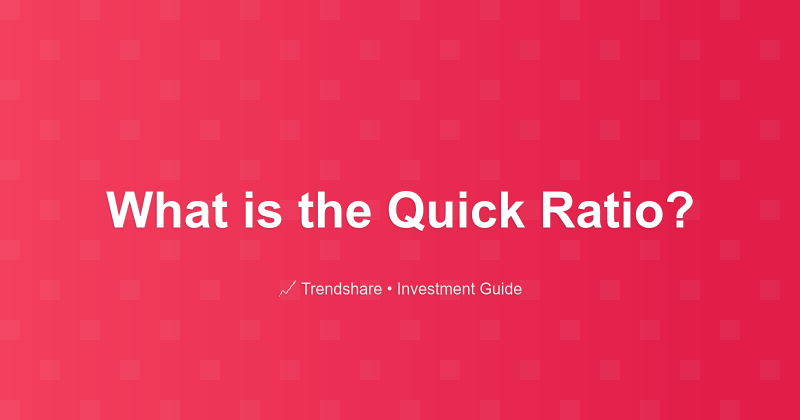
What is the Quick Ratio?
By Ethan Mercer
Financial Technology Analyst • 10+ years in fintech and payments
What is the Quick Ratio? Why this simple financial measurement can tell you whether you should skip buying a stock--and what it can't tell you.
Predicting which stocks will win in the long term is like predicting the outcome of a 100 meter race only 25 meters into it. You have some evidence, but most of the running is still in the future.
The evidence you do have, however, can be really important. If a runner's fallen way behind partway through the race, he'll have to do a lot more work to catch up. Similarly, if a runner's way ahead, she may be able to capitalize on that momentum—or even put more distance between her and the other runners.
In the world of business (the domain of stocks), the ability for one business to use all of its assets to produce revenue and profit is the most important determinant of market success. Every ratio and criterion used to measure the financial health of a business and its potential to earn profit from its assets gives you a picture of that business. Each measurement tells you more about that company's position in the race.
What's Wrong with the Current Ratio?
Some financial measurements track the health of a company and its ability to weather risks. For example, what if the business suddenly had to pay off all of its debts? Could it still make payroll? Would it have to take out long-term loans with unfavorable interest rates? That'd be good to know.
You may be familiar with the current ratio, which compares assets to liabilities. The higher the ratio, the better: it means that the business owns more than it owes.
The current ratio has a big flaw in that it counts inventory as assets. While that's technically true, you don't know that you can sell a warehouse full of pork bellies, iPhone 4s, or Donald Trump for President t-shirts all at once. In fact, you may not ever be able to liquidate that inventory, and you may not be able to sell it all at the price you want. (This is why ideas like mark-to-market accounting come about; but they have their flaws.)
The current ratio gives you an idea of the relationship between assets and liabilities, but it doesn't really answer the question "How much money could you scrape together right now to pay off a debt that's just come due?"
What is the Quick Ratio?
The quick ratio is the comparison between current liquid assets (cash, accounts receivable, liquid securities) and current liabilities. As you can see, the quick ratio excludes inventory. It's like counting the cash in your wallet, your savings account, that really nice Les Paul guitar you can pawn, and the paycheck you're going to get on Friday but not the value of your house (because you'd have to sell your house and go through all of that process to realize it).
You may also hear this called the acid test ratio, but that tends to be an accounting term more than an investing term.
What's a Good Quick Ratio?
As you might expect, having more assets than debt is a good thing. This means you can meet all of your short-term obligations (payroll, debts called in) without destroying your ability to conduct business as usual. A quick ratio of 1.0 or greater indicates that current assets outweigh current liabilities.
If the ratio gets too high, the business may not be investing its money wisely. Perhaps it needs to expand and find new markets. Perhaps it needs to pay a dividend. (People argued that, with billions of dollars of cash in the bank, Apple should pay dividends, which it eventually resumed doing.)
You rarely see a business with a quick ratio too high.
Is a Low Quick Ratio a Sign of Trouble?
Of course having a low quick ratio is dangerous. That business is subject to a lot of risk, and you can probably rule out its stock for the time being. What's low? Anything under 1.0 is a little bit low. As it gets lower, risk increases.
No single financial indicator is a buy/don't buy signal. Every business is slightly different, even within the same sector or industry. Even the act of excluding inventory from current asset calculations means something different for a business with a huge industrial sales cycle (multimillion dollar construction or farming equipment) compared to a business with incredibly quick inventory turnover (computer assembly, consumer technology, groceries). Remember, it's the ability to use assets to produce revenue and profit that matters most, and that depends on a specific business context.
Investment Disclaimer
This article is for educational purposes only and does not constitute investment advice. Stock prices, financial metrics, and market conditions change constantly. Company examples are provided for illustration and should not be considered recommendations. Always verify current data from official sources such as company investor relations pages or SEC filings, assess your own risk tolerance and investment objectives, and consult a qualified financial advisor before making investment decisions. Past performance does not guarantee future results.